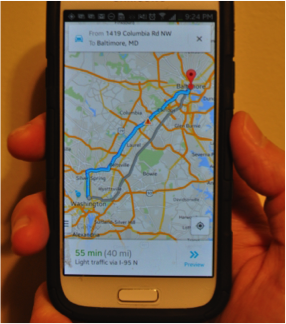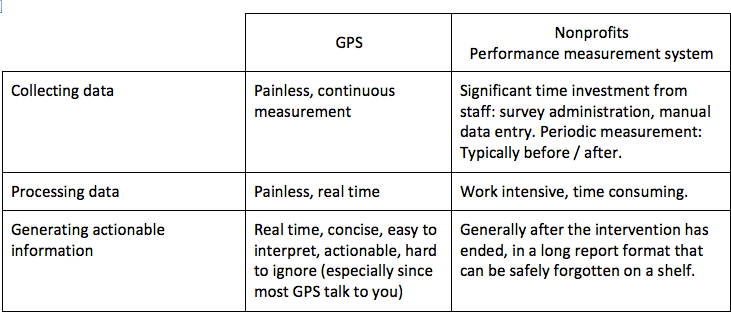Hello! I’m Tony Fujs, Director of Evaluation at the Latin American Youth Center, a DC based non-profit organization. When asked about the role of my department, I often respond that it aims to be “the GPS unit of the organization”, showing decision-makers whether the organization is on track or not toward achieving its goals.
I like the GPS analogy because it is simple and easy to understand. It also provides an interesting framework to think about performance measurement systems, and how to improve them.
Nonprofits Performance measurement systems
Where we are: Where we want to be:


Let’s look at a few concrete examples to illustrate this point:
Lessons Learned: On data collection.
Recognize that data collection is always a burden: Collect only what is needed. Eliminate manual data entry whenever possible; if not possible make the user interface as intuitive as possible.
On data processing. Automate, automate, automate: Internal evaluators generally work with different instances of the same data sets, therefore data cleaning and other analytical tasks can easily be automated: Use programming tools like Excel macros or R. Modern databases can also be customized to automatically “catch” data entry errors.
Hot Tip: Want to learn more about efficient data processing? I’ll be running a workshop on data management at the next EERS conference.
On providing actionable information
Make sure the information generated by the performance measurement system is useful and understandable for the end user.
Make evaluation results hard to ignore: For instance, they could be displayed on a giant TV screen in the hall of the organization building, so nobody can enter the building without seeing them.
Simple is beautiful
Building a culture of data is often cited as a critical step in generating buy-in toward performance measurement systems. It is a critical step indeed, but partly because performance measurement systems are often perceived as complex and cumbersome by the end-user. Drivers adopted the GPS because it is useful and easy to use, not because they developed a culture of data. Building useful, simple, and intuitive performance measurement systems can also be a powerful and sustainable strategy to generate buy-in.
The American Evaluation Association is celebrating Eastern Evaluation Research Society (EERS) Affiliate Week. The contributions all this week to aea365 come from EERS members. Do you have questions, concerns, kudos, or content to extend this aea365 contribution? Please add them in the comments section for this post on the aea365 webpage so that we may enrich our community of practice. Would you like to submit an aea365 Tip? Please send a note of interest to aea365@eval.org. aea365 is sponsored by the American Evaluation Association and provides a Tip-a-Day by and for evaluators.

